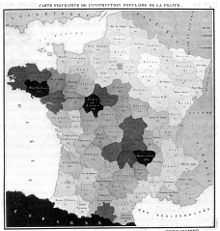Charles Dupin

Pierre Charles François Dupin (October 6, 1784, Varzy, Nièvre – January 18, 1873, Paris, France) was a French Catholic mathematician, engineer, economist[1] and politician, particularly known for work in the field of mathematics, where the Dupin cyclide and Dupin indicatrix are named after him; and for his work in the field of statistical and thematic mapping,[2] In 1826 he created the earliest known choropleth map.[3]
Life and work
He studied geometry with Monge at the École Polytechnique and then became a naval engineer. In 1819 he was appointed professor at the Conservatoire des Arts et Métiers; he kept this post until 1854. In 1822, he was elected a foreign member of the Royal Swedish Academy of Sciences.
In 1808, he participated in the Greek science revival by teaching mathematics and mechanics lessons in Corfu. One of his students was Giovanni Carandino, who would go on to be the founder of the Greek Mathematics School in the 1820s.

In 1826 he published a thematic map showing the distribution of illiteracy in France, using shadings (from black to white), the first known instance of what is called a choropleth map today.[3] Duplin had been inspired by the work of the German statisticians Georg Hassel and August Friedrich Wilhelm Crome.[2]
In addition, he had a political career and was appointed to the Senate in 1852. His mathematical work was in descriptive and differential geometry. He was the discoverer of conjugate tangents to a point on a surface and of the Dupin indicatrix.
Selected publications
- Dupin, François Pierre Charles. Développements de géométrie. (1813).
- Dupin, François Pierre Charles. Discours et leçons sur l'industrie, le commerce, la marine, et sur les sciences appliquées aux arts. 1825.
- Dupin, François Pierre Charles. Canal maritime de Suez. Imprimerie de Mallet-Bachelier, 1858.
References
- ↑ Entry in Catholic Encyclopedia
- ↑ 2.0 2.1 Palsky, Gilles. "Connections and Exchanges in European Thematic Cartography. The case of XIXth century choropleth maps." Formatting Europe. Mapping a continent. 2007
- ↑ 3.0 3.1 Michael Friendly (2008). "Milestones in the history of thematic cartography, statistical graphics, and data visualization".
External links
| Wikimedia Commons has media related to Charles Dupin. |
|
| |||||||||||||||||||||||||||||||||||||||||||||
.svg.png)
